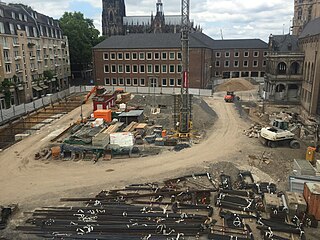
An architect is a person who plans, designs, and oversees the construction of buildings. To practice architecture means to provide services in connection with the design of buildings and the space within the site surrounding the buildings that have human occupancy or use as their principal purpose. Etymologically, the term architect derives from the Latinarchitectus, which derives from the Greek, i.e., chief builder.

Construction is a general term meaning the art and science of forming objects, systems, or organizations. It comes from the Latin word constructio and Old French construction. To 'construct' is a verb: the act of building, and the noun is construction: how something is built or the nature of its structure.
A subcontractor is a person or business that undertakes to perform part or all of the obligations of another's contract.
A mechanic's lien is a security interest in the title to property for the benefit of those who have supplied labor or materials that improve the property. The lien exists for both real property and personal property. In the realm of real property, it is called by various names, including, generically, construction lien. The term "lien" comes from a French root, with a meaning similar to link, which is itself ultimately descended from the Latin ligamen, meaning "bond" and ligare, meaning "to bind". Mechanic's liens on property in the United States date from the 18th century.
Design–build, also known as alternative delivery, is a project delivery system used in the construction industry. It is a method to deliver a project in which the design and construction services are contracted by a single entity known as the design–builder or design–build contractor. It can be subdivided into architect-led design–build and contractor-led design–build.
Design–bid–build, also known as Design–tender, traditional method, or hardbid, is a project delivery method in which the agency or owner contracts with separate entities for the design and construction of a project.
Construction management (CM) aims to control the quality of a project's scope, time, and cost to maximize the project owner's satisfaction. It uses project management techniques and software to oversee the planning, design, construction and closeout of a construction project safely, on time, on budget and within specifications.
A management contract is an arrangement under which operational control of an enterprise is vested by contract in a separate enterprise that performs the necessary managerial functions in return for a fee. Management contracts involve not just selling a method of doing things but actually doing them. A management contract can involve a wide range of functions such as technical operation of a production facility, management of personnel, accounting, marketing services, and training.
The Joint Contracts Tribunal, also known as the JCT, produces standard forms of contract for construction, guidance notes and other standard documentation for use in the construction industry in the United Kingdom. From its establishment in 1931, JCT has expanded the number of contributing organisations. Following recommendations in the 1994 Latham Report, the current operational structure comprises seven members who approve and authorise publications. In 1998 the JCT became a limited company.
On large construction projects, the superintendent's job is to run the day-to-day operations on the construction site and control the short-term schedule. The role of the superintendent also includes important quality control and subcontractor coordination responsibilities. It is common for most finance-related tasks and long-term scheduling to be handled by a project manager. The project manager and superintendent need to cooperate and share control effectively. Superintendents are almost universally stationed on the construction site, while project managers are usually based in the contractor's office with part-time on site responsibilities.
Construction bidding is the process of submitting a proposal (tender) to undertake, or manage the undertaking of a construction project. The process starts with a cost estimate from blueprints and material take offs.
In construction, commissioning or commissioning process is an integrated, systematic process to ensure, through documented verification, that all building systems perform interactively according to the "Design Intent". The commissioning process establishes and documents the "Owner's Project Requirements (OPR)" criteria for system function, performance expectations, maintainability; verify and document compliance with these criteria throughout all phases of the project. Commissioning procedures require a collaborative team effort and 'should' begin during the pre-design or planning phase of the project, continue through the design and construction phases, initial occupancy phase, training of operations and maintenance (O&M) staff, and into occupancy.
Construction law is a branch of law that deals with matters relating to building construction, engineering, and related fields. It is in essence an amalgam of contract law, commercial law, planning law, employment law and tort. Construction law covers a wide range of legal issues including contract, negligence, bonds and bonding, guarantees and sureties, liens and other security interests, tendering, construction claims, and related consultancy contracts. Construction law affects many participants in the construction industry, including financial institutions, surveyors, quantity surveyors, architects, carpenters, engineers, construction workers, and planners.
Construction cost estimating software is computer software designed for contractors to estimate construction costs for a specific project. A cost estimator will typically use estimating software to estimate their bid price for a project, which will ultimately become part of a resulting construction contract. Some architects, engineers, construction managers, and others may also use cost estimating software to prepare cost estimates for purposes other than bidding such as budgeting and insurance claims.
The New Engineering Contract (NEC), or NEC Engineering and Construction Contract, is a formalised system created by the UK Institution of Civil Engineers that guides the drafting of documents on civil engineering, construction and maintenance projects for the purpose of obtaining tenders, awarding and administering contracts. The NEC contract is widely used in the United Kingdom. There have been attempts, largely unsuccessful, to introduce the NEC contract into both Australia and New Zealand from at least 1994 but the contract remains relatively obscure in both countries.

Real estate development, or property development, is a business process, encompassing activities that range from the renovation and re-lease of existing buildings to the purchase of raw land and the sale of developed land or parcels to others. Real estate developers are the people and companies who coordinate all of these activities, converting ideas from paper to real property. Real estate development is different from construction or housebuilding, although many developers also manage the construction process or engage in housebuilding.
Fast-track building construction is construction industry jargon for a project delivery strategy to start construction before the design is complete. The purpose is to shorten the time to completion.
Retainage is a portion of the agreed upon contract price deliberately withheld until the work is complete to assure that contractor or subcontractor will satisfy its obligations and complete a construction project. A retention is money withheld by one party in a contract to act as security against incomplete or defective works. They have their origin in the British construction industry Railway Mania of the 1840s but are now common across the industry, featuring in the majority of construction contracts. A typical retention rate is 5% of which half is released at completion and half at the end of the defects liability period. There has been criticism of the practice for leading to uncertainty on payment dates, increasing tensions between parties and putting monies at risk in cases of insolvency. There have been several proposals to replace the practice with alternative systems.
Pre-construction services are services that are offered to support owners, architects, and engineers in making decisions. They are used in planning a construction project before the actual construction begins. The stage where these services are offered is called pre-construction or "pre-con".
A construction contract is a mutual or legally binding agreement between two parties based on policies and conditions recorded in document form. The two parties involved are one or more property owners and one or more contractors. The owner, often referred to as the 'employer' or the 'client', has full authority to decide what type of contract should be used for a specific development to be constructed and to set out the legally-binding terms and conditions in a contractual agreement. A construction contract is an important document as it outlines the scope of work, risks, duration, duties, deliverables and legal rights of both the contractor and the owner.


